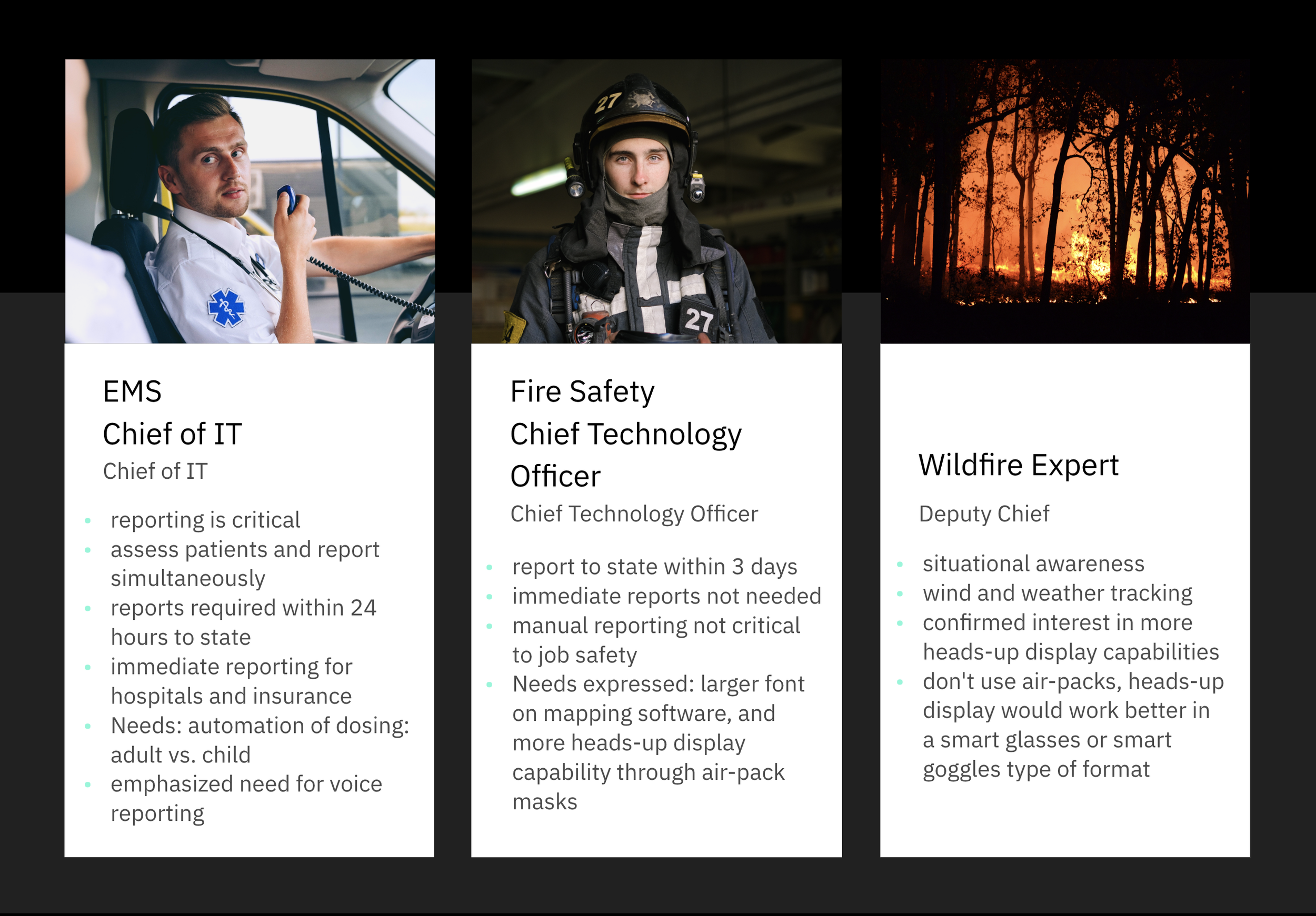
AI Report Generation for First Responders
AI Report Generation for First Responders
How might we use AI technology to assist in report generation?
Our research focuses on the exploration of AI technology, firefighting processes, and critical information capture necessary during wildfire incidents.
The original brief for this project focused on the exploration of AI Technology with voice input for the purposes of aiding EMS with report generation. However, after meeting with the client we realized that the project was an exploratory project.
Client: Indiana Crisis Technology Lab
ROLE: UX Researcher
We segmented the project into four chunks.
How do we approach this broad exploratory project?
Narrowing focus and targeting areas for exploratory research.
Focus versus exploration…
Methods
Desk Research: Literature Review_01
We split Desk Research into 5 areas
Desk Research_01:
Artificial Intelligence and how it works
Over simplified general AI process…
Desk Research_01
2. Past Firefighting Technology
Past Technology created for firefighters was:
costly
complicated
time-consuming to learn and use
not enough accuracy
extra equipment can get in the way
Focus on current equipment and technology and how we might repurpose as opposed to creating a new technology
What do fire fighters have on their uniform that we could repurpose?
Desk Research_01
3. Current Firefighting Technology
Take a minute to write an introduction that is short, sweet, and to the point. If you sell something, use this space to describe it in detail and tell us why we should make a purchase. Tap into your creativity. You’ve got this.
Desk Research_01
4. Current fire incident report processes and reports
Desk Research_01
5. Wildfire Incidents
A series of 16 tragic wildfires, occurring between 1937 and 1956 prompted the USDA Forest Service to create 10 Standard Firefighting orders, developed in 1957. These 10 Standard Firefighting Orders were developed to manage the unpredictable nature of wildfires and save the lives of personnel working under these conditions.
The Anatomy of a Wildfire
Wildfire Training Videos Source: South King County Fire Training Consortium: Wildland Urban Interface Awareness Videos 1, 2, 3, and 4
Anchor Points
Insights from Wildfire Research…
Situational awareness is key to managing wildfire incidents.
Need to know what the fire is doing at all times.
How does wind affect fire movement?
Where are safety zones?
Who is on site and where are they?
What resources are available?
New questions emerge.
What kinds of input data could we collect on situational awareness and environmental conditions that would benefit firefighters?
Could we capture satellite images of the wildfire and label the main components of the fire? (head, heel, fingers, etc.)
How might we capture and display constantly changing weather conditions?
Subject Matter Expert Interviews: Insights
Observation/Mini-Contextual Inquiry
What we learned…
Fire administration has strong reporting systems in place
While missing reports are an issue, there is a strong management system in place and automated notifications are sent to those who are missing reports
Reports are not time sensitive and Incident Commanders have up to 3 days to submit reports
Reporting done after the incident not during
Manual reporting did not seem to affect critical aspects of the ongoing incident
Reporting narratives are used as evidence in court cases and for insurance purposes
Data gathered from this method pushed us in a new direction:
Away from AI Report generation and towards a focus on non-traditional reporting of environmental factors like; wind-tracking, weather tracking, fire tracking, and how we might capture those elements.
Affinity Diagram
Insights from Affinity Diagram
Initial Goals Versus Results
Next Steps…
DESK RESEARCH: PHASE 2
Explore inputs for an AI algorithm that could track fire movement, location, and how wind might affect the direction of the fire.
Suggest researching AI and wind tracking, AI and location tracking, and AI and heat tracking.
Further exploration of heads-up displays for air-pack masks, smart glasses, and smart goggles format.
Initial prototypes and sketches
testing and validation with firefighters



















